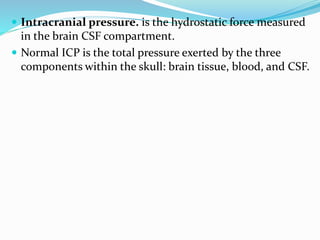This document discusses intracranial pressure (ICP) and factors that influence it such as cerebral blood flow. It defines normal ICP and describes how ICP can be measured. Increased ICP is discussed including potential causes such as cerebral edema and mass lesions. Clinical manifestations of increased ICP are outlined including changes in vital signs, ocular signs, decreased motor function, and headache. Diagnostic studies and collaborative therapies to manage increased ICP are also summarized.

































![• Corticosteroids (dexamethasone [Decadron]) (for brain
tumors, bacterial meningitis):
They act by stabilizing the cell membrane and by
inhibiting the synthesis of prostaglandins thus preventing
the formation of proinflammatory mediators.
Corticosteroids are also thought to improve neuronal
function by improving CBF and restoring autoregulation.
• Histamine (H2)-receptor antagonist or proton pump
inhibitor to prevent GI ulcers and bleeding](https://image.slidesharecdn.com/icp-230811043418-3e6a2307/85/ICP-pptx-34-320.jpg)



